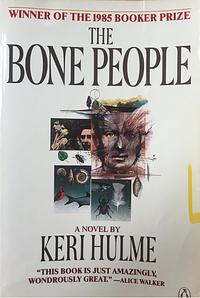Take a photo of a barcode or cover
The Bone People, the 1985 Booker Prize winning novel by New Zealander Keri Hulme, is a mysterious and multifaceted work of art. In a nutshell, the story follows the complicated, interconnected relationships of three characters: Kerewin Holmes, Joe Gillayley, and Simon Gillayley. At the beginning of the novel, Kerewin, an artist living an isolated life in a stone tower in New Zealand, is startled to find Simon (eight years old, wild-of-hair, and mute) taking refuge from a storm in her home. Though Simon communicates only through a crude, improvised sort of sign language, Kerewin is able to make a connection with him in the hours it takes to track down his adoptive father, Joe. Over the next year or so, Kerewin develops a friendship with Joe and Simon that is at once intimate (but platonic), necessary, tumultuous, intense, and ever-tenuous. Their little ersatz family unit has its ups (notably a vacation to a craggy beachfront property owned by Kerewin’s estranged family) and its downs (the revelation that Joe drinks too much and hits Simon), and the reader is vertiginously dragged along for the ride.
Reflecting on the themes of The Bone People, words like “hybrid” and “mixture” come to mind most readily. Modern New Zealand culture has developed jointly from the traditions of New Zealanders of European ancestry and those of Maori ancestry. The resulting cultural tension is the thematic engine that drives the novel. The most immediate example of this is in the main characters themselves. Simon is European (he was found washed up on a beach after a storm several years before the novel begins), Joe—who found and adopted Simon with his now-deceased wife—is fully Maori, and Kerewin is half-European and half-Maori. As their relationships develop, it is easy to view Kerewin, Joe, and Simon as stand-ins for the contrasting cultures themselves. The cultural-hybrid theme is further illustrated by the use of language in the novel. Kerewin and Joe routinely slip back and forth between English and Maori phrases. (Fortunately, there is a useful Maori glossary in the back of the book for those of us not fluent in Maori.) The author also represents the cultural tension in New Zealand by utilizing different writing styles in different sections of the book. Most notable is the abrupt tonal shift towards the end of the book from a relatively straightforward style in the European tradition to an enigmatic and mystical style based on Maori mythology. Each of these representations of the cultural differences in New Zealand allegorically serve to evoke life in New Zealand itself.
The Bone People is a difficult book to read on several levels. The writing itself can be maddeningly idiosyncratic, the random bits of Maori can be jarring, and the visceral descriptions of Simon’s abuse at the hands of his adoptive father can be brutal and unforgiving. However, taken as a whole this is an ambitious and bold novel, lush with symbolism and thematically rich (far more than this short review can convey). It is also deeply rooted in the multifaceted culture of New Zealand. No single book can truly encapsulate a nation’s je ne sais quoi, but for U.S. readers hoping to peek onto the other side of the world, this would be an excellent place to start.
Reflecting on the themes of The Bone People, words like “hybrid” and “mixture” come to mind most readily. Modern New Zealand culture has developed jointly from the traditions of New Zealanders of European ancestry and those of Maori ancestry. The resulting cultural tension is the thematic engine that drives the novel. The most immediate example of this is in the main characters themselves. Simon is European (he was found washed up on a beach after a storm several years before the novel begins), Joe—who found and adopted Simon with his now-deceased wife—is fully Maori, and Kerewin is half-European and half-Maori. As their relationships develop, it is easy to view Kerewin, Joe, and Simon as stand-ins for the contrasting cultures themselves. The cultural-hybrid theme is further illustrated by the use of language in the novel. Kerewin and Joe routinely slip back and forth between English and Maori phrases. (Fortunately, there is a useful Maori glossary in the back of the book for those of us not fluent in Maori.) The author also represents the cultural tension in New Zealand by utilizing different writing styles in different sections of the book. Most notable is the abrupt tonal shift towards the end of the book from a relatively straightforward style in the European tradition to an enigmatic and mystical style based on Maori mythology. Each of these representations of the cultural differences in New Zealand allegorically serve to evoke life in New Zealand itself.
The Bone People is a difficult book to read on several levels. The writing itself can be maddeningly idiosyncratic, the random bits of Maori can be jarring, and the visceral descriptions of Simon’s abuse at the hands of his adoptive father can be brutal and unforgiving. However, taken as a whole this is an ambitious and bold novel, lush with symbolism and thematically rich (far more than this short review can convey). It is also deeply rooted in the multifaceted culture of New Zealand. No single book can truly encapsulate a nation’s je ne sais quoi, but for U.S. readers hoping to peek onto the other side of the world, this would be an excellent place to start.
I loved this book. I can definitely see why it was a multiple prize winner. It made me think about life, and I shed a few tears. It's a difficult read at times, as is any book which includes abuse. Ultimately, it's a book about family, relationships, and finding your way back to what you have lost.
A very deep book with dark and troubling issues. Worth the read. The language is hard at times but the story itself is beautiful.
🇳🇿 📖 The back of this books describes itself as “cruel, funny, ardent and beautiful” and I agree with this. There’s Maori sentences used in it which is awesome, translations are at the back of the book
emotional
mysterious
reflective
tense
slow-paced
Plot or Character Driven:
Character
Strong character development:
Yes
Loveable characters:
Yes
Diverse cast of characters:
Yes
Flaws of characters a main focus:
Yes
I just don't buy the solution the author presents for all the serious issues all of the characters have. And trust me, they've got some serious problems. I understand that this novel is addressing a real, serious issue, but I don't see how the ending does it justice.
On the other hand I enjoyed the style and the sense of mystery and suspense.
_______________________
Edit: Maybe I'm approaching this all wrong. Maybe if I had a better understanding of the culture I'd understand the metaphor of the change that each character undergoes better than I do now.
On the other hand I enjoyed the style and the sense of mystery and suspense.
_______________________
Edit: Maybe I'm approaching this all wrong. Maybe if I had a better understanding of the culture I'd understand the metaphor of the change that each character undergoes better than I do now.
Loved it years ago (one of the first ace characters I remember reading, remember how that stuck with me), want to read it again.
challenging
dark
mysterious
sad
slow-paced
Plot or Character Driven:
Character
Strong character development:
Complicated
Loveable characters:
Complicated
Diverse cast of characters:
Yes
Flaws of characters a main focus:
Yes
Wanted to love this book so much, but as others have written, the character arcs are tough to love. I almost wonder if the last 100 pages were written with a different ending and then the editor or publisher asked her to tack on the final 20 pages with a nicer resolution.
Glimpsing into Maori culture was fascinating and I'm glad I read this book for that reason. Otherwise, not a favorite. Everyone needed to be in therapy. Lots of therapy. And it really made this a tough read.
Glimpsing into Maori culture was fascinating and I'm glad I read this book for that reason. Otherwise, not a favorite. Everyone needed to be in therapy. Lots of therapy. And it really made this a tough read.
Graphic: Child abuse
Moderate: Adult/minor relationship, Alcoholism, Child death, Chronic illness, Violence
Minor: Cancer
adventurous
challenging
dark
emotional
funny
hopeful
informative
inspiring
mysterious
reflective
sad
tense
medium-paced
Plot or Character Driven:
Character
Strong character development:
Yes
Loveable characters:
Yes
Diverse cast of characters:
Yes
Flaws of characters a main focus:
Yes
Graphic: Alcoholism, Animal death, Bullying, Child abuse, Death, Domestic abuse, Emotional abuse, Physical abuse, Forced institutionalization, Blood, Grief
Moderate: Drug abuse, Drug use, Suicide attempt
Minor: Child death, Homophobia, Pedophilia, Suicidal thoughts, Cannibalism, Car accident, Death of parent
A strange, poetic read. The characters are very real, very human and flawed. There are moments when I wanted to cheer for that odd trio of Kerewin, Simon and Joe. At other times I wanted to shake them, especially the adults. It is gorgeous and painful. Poetic and fragmented and intriguing. There are themes of identify, found lost and in question, and themes of family and home and how to define them. The end felt a little bit like a happily ever after, especially after seeing less of the transformations that led everyone to get to that point. But it also felt right.




